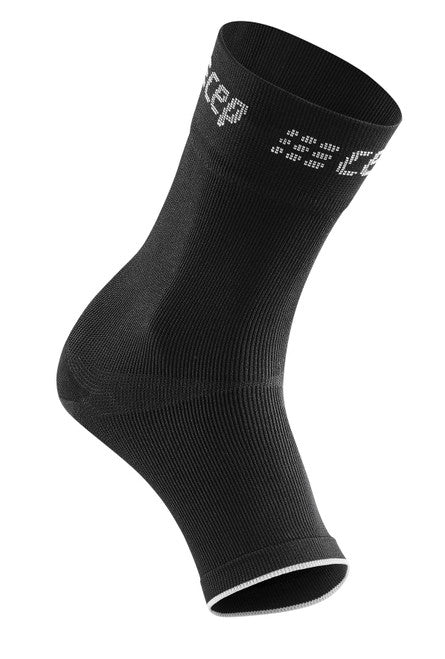Achilles tendonitis is a surprisingly common condition that affects thousands of Americans every year. While Achilles tendonitis does not require surgery in most cases, failing to get treatment or not allowing your body to rest could exacerbate the condition. Fortunately, compression is a common treatment option that can help reduce the symptoms of Achilles tendonitis and prevent a mild or moderate case from becoming more severe.
But what exactly is Achilles tendonitis? What causes it? How do compression garments help treat the condition? Finally, where can you acquire high-quality compression wear to help with your Achilles tendonitis treatment?
In today’s guide, we will answer all of these questions and more. However, it’s important to note that you should always speak to your doctor before trying compression wear to treat any medical condition, including Achilles tendonitis.
What Is Achilles Tendonitis?
The Achilles tendon is the tissue that connects the heel bone in the foot to the muscles in the calf. It is considered to be the strongest tendon in the body, capable of supporting much of the body’s weight and allowing forward motion, like walking, running, and jumping. Since the Achilles tendon plays a vital role in the kinetics of the body, any pain or discomfort in the area can make it difficult to move around as you normally would.
Achilles tendonitis tends to manifest itself as Achilles tendon pain, as well as tenderness along the entire heel and back of the ankle. Additional symptoms can include stiffness, swelling, and difficulty walking or putting weight on the ball of the foot. It’s important to note that Achilles tendonitis can happen in one ankle or both ankles simultaneously.
The condition most often occurs in professional or recreational runners, as well as people who play other kinds of sports. It can happen in people of any age, though it is typically associated with overexertion of the muscles and tendons of the ankles. As a result, it frequently occurs in younger people, as well as those in middle age who continue to engage in high-impact sports.
The treatment for Achilles tendonitis can vary based on the severity of your condition. Achilles tendonitis is generally categorized into mild, moderate, and severe cases:
- Mild - There is pain in the Achilles area while running or immediately after engaging in physical activity.
- Moderate - There is often more pain, accompanied by swelling and possibly a lump on the Achilles tendon.
- Severe - There is pain that makes it impossible to walk or stand comfortably. In some cases, the Achilles tendon may even tear.
Causes of Achilles Tendonitis
The underlying cause of the condition can also impact its severity. Here are a few of the most common causes of Achilles tendonitis:
- Arch Problems - People with flat feet or a high arch are more prone to injuries to the Achilles tendon. This is because malformed arches can put additional strain on the Achilles tendon and potentially lead to pain or tearing.
- Poor Footwear - Wearing the wrong kind of shoes, particularly during physical activities, can greatly increase the risk of Achilles tendonitis.
- Overuse - One of the most common causes of Achilles tendonitis is injury caused by overuse or overexertion. Engaging in long runs and playing basketball for extended periods of time are two activities that could lead to Achilles tendonitis.
- High BMI - If you’re obese or have a high BMI, you could be putting additional pressure on your Achilles tendon.
- Arthritis - In some cases, Achilles tendonitis could be a side effect of generalized inflammatory arthritis.
How Compression Helps Achilles Tendonitis
There are various treatment options for Achilles tendonitis, many of which can be done at home. For instance, your doctor may recommend resting your feet and legs and taking over-the-counter medication for pain and inflammation. In more severe cases, you may need to engage in physical therapy, cut out most exercise, or even undergo surgery. Additionally, many doctors recommend compression wear to speed up the healing process.
Remember, it’s vitally important to speak to your doctor before using compression wear to treat Achilles tendonitis. In certain cases, compression socks and similar garments may not be the best solution. That said, compression can help alleviate the symptoms associated with mild or moderate Achilles tendonitis for many people.
Compression works to treat Achilles tendonitis in two distinct ways. First, applying consistent pressure to the area can help reduce swelling and offer significant alleviation from pain. And second, compression wear can help keep your foot, ankle, and lower leg stationary while you recover. This substantially reduces the risk of exacerbating the condition or experiencing a rupture of the Achilles tendon.
Compression Socks For Achilles Tendonitis
As long as your doctor believes that you’re a good fit for compression socks, you can benefit greatly from making them a part of your Achilles tendonitis treatment. Not only do compression socks help keep your foot in place, but they offer relief from the discomfort caused by the condition. Since compression socks cover the entirety of the foot and the lower leg, they also offer more comprehensive relief than compression wraps or other garments that may only address the ankle.
However, it’s important to keep in mind that compression socks alone will not cure the condition. In most cases, you will need to combine various treatments to reduce pain and swelling and give your Achilles tendon time to heal. For instance, many patients are instructed to avoid rigorous physical activities, take OTC pain medication as needed, apply ice packs when the pain is most severe, and use shoe inserts to take pressure off of the Achilles tendon. Compression wear, in conjunction with some or all of these treatment methods, can help your body rebuild and recover faster.
If you and your doctor determine that compression socks are the best solution for you, be sure to check out Compression Health to find the best compression socks for Achilles tendonitis.
How Long Should You Wear Compression Socks For Achilles Tendonitis?
The length of time you will need to wear compression socks depends on the severity of your condition. In mild cases, you may only need to wear compression socks for one or two weeks, in conjunction with rest and other treatment methods. However, if the condition is moderate or severe, you might need to wear compression socks for a month or longer.
Alternatively, if your Achilles tendonitis requires surgery, you’ll typically need to wear the socks for one to two weeks following the procedure. During this time, it is usually recommended that you wear them throughout the day and only take them off when showering or changing clothes. However, the exact routine may vary based on the recommendations of your doctor.
Compression Sleeves For Achilles Tendonitis
In certain situations, compression socks may not be ideal. For example, if you prefer to let your toes breathe or you want compression wear that can be worn higher up on the leg, you might opt for compression sleeves. These sleeves function much in the same way as compression socks, except that you have more freedom to determine exactly where they will go on your lower leg and upper foot. Moreover, compression sleeves can help you apply more targeted pressure to the Achilles tendon and ankle area.
If you and your doctor determine that compression sleeves are the best solution for you, be sure to check out Compression Health to find the best compression sleeves for Achilles tendonitis.
We hope you found this guide on compression for Achilles tendonitis both useful and informative! Are you currently in the market for compression socks, sleeves, or other compression wear? If so, be sure to reach out to Compression Health today!




Share:
Incrediwear Knee Sleeve Guide
Lymphedema Wraps Guide